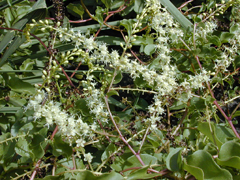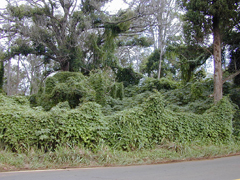 |
|
www.starrenvironmental.com |
 |
| www.starrenvironmental.com |
Translate this page:
Summary
A perennial evergreen succulent climbing plant native to South America. As an ornamental it is easily trained to twine up trellises, fences, or rock walls for decoration or for screening.
Physical Characteristics

 Anredera is an evergreen Perennial Climber growing to 9 m (29ft) by 0.2 m (0ft 8in) at a fast rate.
Anredera is an evergreen Perennial Climber growing to 9 m (29ft) by 0.2 m (0ft 8in) at a fast rate.
See above for USDA hardiness. It is hardy to UK zone 9 and is frost tender. It is in flower from July to October. The species is hermaphrodite (has both male and female organs).
Suitable for: light (sandy), medium (loamy) and heavy (clay) soils and prefers well-drained soil. Suitable pH: mildly acid, neutral and basic (mildly alkaline) soils. It can grow in semi-shade (light woodland) or no shade. It prefers moist soil and can tolerate drought.
UK Hardiness Map
US Hardiness Map
Synonyms
Plant Habitats
Edible Uses
Root - cooked. We were supplied this plant by a friend who said that the root is edible. We have not seen any reports on its edibility. The raw root is crisp and pleasant when first put in the mouth, but soon degenerates into a mucilaginous mass described by some people as 'like eating catarrh' and in rather less flattering terms by others![K]. When well baked, the root loses this quality and is quite pleasant to eat[K]. Leaves cooked. Used as a spinach[264].
References More on Edible Uses
Medicinal Uses
Plants For A Future can not take any responsibility for any adverse effects from the use of plants. Always seek advice from a professional before using a plant medicinally.
The plant has been shown to have anti-inflammatory, anti-ulcer, and liver-protective effects[270].
References More on Medicinal Uses
The Bookshop: Edible Plant Books
Our Latest books on Perennial Plants For Food Forests and Permaculture Gardens in paperback or digital formats.

Edible Tropical Plants
Food Forest Plants for Hotter Conditions: 250+ Plants For Tropical Food Forests & Permaculture Gardens.
More

Edible Temperate Plants
Plants for Your Food Forest: 500 Plants for Temperate Food Forests & Permaculture Gardens.
More

More Books
PFAF have eight books available in paperback and digital formats. Browse the shop for more information.
Shop Now
Other Uses
An ornamental succulent vine. For landscaping purposes. Fast growing possessing fragrant white flowers, easily trained to twine up trellises, fences, or rock walls for decoration or for screening.
Special Uses
References More on Other Uses
Cultivation details
Requires a well-drained humus-rich soil and a position in full sun or good indirect light[200]. Established plants are drought tolerant[200]. This plant seldom, if ever, produces seeds[266]. We have very little information on this plant. The top growth is almost certainly not frost-hardy, though plants have continued growing in a polyhouse when other sensitive plants have died back as a result of frost damage[K]. The tubers have also survived outdoors in a sunny sheltered position for three winters outdoors (as of May 2004), the plant coming back into growth in late spring[K]. )The roots are likely to be hardier and, especially if well mulched, should survive most winters outdoors in the milder areas of the country. They are unlikely to survive sharp or persistent frosts. It should be possible to harvest the roots in the autumn after the top growth has been killed by frost and then store them in a cool but frost-free place for the winter, planting out in late spring (perhaps starting them off in a greenhouse beforehand)[K]. A climbing plant, supporting itself by twining around the thin branches of other plants[K].
References Carbon Farming Information and Carbon Sequestration Information
Temperature Converter
Type a value in the Celsius field to convert the value to Fahrenheit:
Fahrenheit:
The PFAF Bookshop
Plants For A Future have a number of books available in paperback and digital form. Book titles include Edible Plants, Edible Perennials, Edible Trees,Edible Shrubs, Woodland Gardening, and Temperate Food Forest Plants. Our new book is Food Forest Plants For Hotter Conditions (Tropical and Sub-Tropical).
Shop Now
Plant Propagation
Seed - we have no information on this plant, but, if seed can be obtained, suggest sowing it in a greenhouse in the spring. Prick out the seedlings into individual pots when they are large enough to handle and grow them on in the greenhouse for at least their first winter. Plant out in spring after the last expected frosts. Softwood cuttings. Division. Dig up the tubers at any time from late autumn to early spring. Store them in a cool but frost-free place and either pot them up in the greenhouse in early spring or plant them directly outside in late spring.
Other Names
If available other names are mentioned here
Native Range
SOUTHERN AMERICA: Brazil (Paraná, Rio Grande do Sul, Santa Catarina), Bolivia, Argentina (Córdoba, Buenos Aires, Catamarca, Chaco, Corrientes, Entre Ríos, Formosa, Jujuy, Misiones, Salta, San Luis, Santa Fe, Santiago del Estero, Tucumán, Ciudad Autónoma de Buenos Aires), Paraguay, Uruguay
Weed Potential
Right plant wrong place. We are currently updating this section.
Please note that a plant may be invasive in one area but may not in your area so it’s worth checking.
Very invasive in several introduced countries including Australia, New Zealand and on Pacific islands. It is considered an invasive species in many tropical and sub-tropical localities.
Conservation Status
IUCN Red List of Threatened Plants Status : This taxon has not yet been assessed.

Growth: S = slow M = medium F = fast. Soil: L = light (sandy) M = medium H = heavy (clay). pH: A = acid N = neutral B = basic (alkaline). Shade: F = full shade S = semi-shade N = no shade. Moisture: D = dry M = Moist We = wet Wa = water.
Expert comment
Author
(Ten.)Steenis.
Botanical References
200266
Links / References
For a list of references used on this page please go here
Readers comment
| Add a comment |
|
If you have important information about this plant that may help other users please add a comment or link below. Only comments or links that are felt to be directly relevant to a plant will be included. If you think a comment/link or information contained on this page is inaccurate or misleading we would welcome your feedback at [email protected]. If you have questions about a plant please use the Forum on this website as we do not have the resources to answer questions ourselves.
* Please note: the comments by website users are not necessarily those held by PFAF and may give misleading or inaccurate information.
To leave a comment please Register or login here All comments need to be approved so will not appear immediately.
|
|